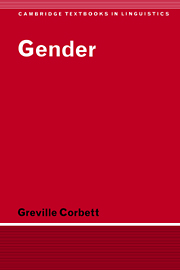Book contents
- Frontmatter
- Contents
- List of figures
- List of tables
- Preface
- List of abbreviations
- 1 INTRODUCTION
- 2 GENDER ASSIGNMENT I: SEMANTIC SYSTEMS
- 3 GENDER ASSIGNMENT II: FORMAL SYSTEMS
- 4 THE PSYCHOLINGUISTIC STATUS OF GENDER ASSIGNMENT
- 5 GENDER AGREEMENT
- 6 ESTABLISHING THE NUMBER OF GENDERS
- 7 TARGET GENDERS: SYNCRETISM AND ENFORCED GENDER FORMS
- 8 HYBRID NOUNS AND THE AGREEMENT HIERARCHY
- 9 GENDER RESOLUTION RULES
- 10 GENERALIZATIONS AND PROSPECTS
- References
- Author index
- Language index
- Subject index
10 - GENERALIZATIONS AND PROSPECTS
Published online by Cambridge University Press: 05 June 2012
- Frontmatter
- Contents
- List of figures
- List of tables
- Preface
- List of abbreviations
- 1 INTRODUCTION
- 2 GENDER ASSIGNMENT I: SEMANTIC SYSTEMS
- 3 GENDER ASSIGNMENT II: FORMAL SYSTEMS
- 4 THE PSYCHOLINGUISTIC STATUS OF GENDER ASSIGNMENT
- 5 GENDER AGREEMENT
- 6 ESTABLISHING THE NUMBER OF GENDERS
- 7 TARGET GENDERS: SYNCRETISM AND ENFORCED GENDER FORMS
- 8 HYBRID NOUNS AND THE AGREEMENT HIERARCHY
- 9 GENDER RESOLUTION RULES
- 10 GENERALIZATIONS AND PROSPECTS
- References
- Author index
- Language index
- Subject index
Summary
In this concluding chapter we draw out and develop some general themes which have emerged in our study of gender; we will also take a look backwards at earlier work and forwards to what may be achieved by future research. The notions of meaning and form provide an entry point for reviewing parts of our study and some previous research (section 10.1). The review of earlier work leads us to a discussion of the development and loss of gender systems (section 10.2). Finally, we look at the prospects in this area, both for understanding major questions of the function of gender and for feasible shorter-term projects (section 10.3).
Meaning and form
The relationship between meaning and form is central to linguistics and, not surprisingly, the theme runs through our investigation of gender (section 10.1.1), and through earlier work on the subject (section 10.1.2).
A perspective on gender systems
We saw in chapter 6 how establishing the existence of a gender system and determining the number of genders requires evidence from agreement (that is, evidence concerned with form). At the same time, gender always has a semantic core: there are no gender systems in which the genders are purely formal categories. As shown in chapters 2 and 3, nouns are assigned to gender according to semantic and formal criteria. At one end of the range we find languages like Tamil, in which the meaning of a noun is sufficient to assign it to a gender.
- Type
- Chapter
- Information
- Gender , pp. 307 - 323Publisher: Cambridge University PressPrint publication year: 1991
- 1
- Cited by



